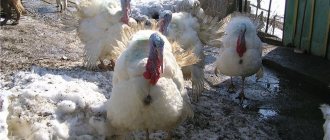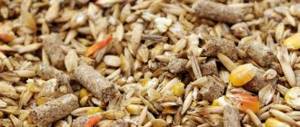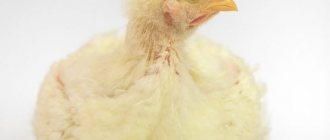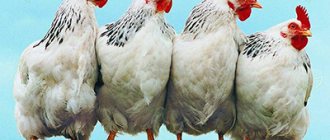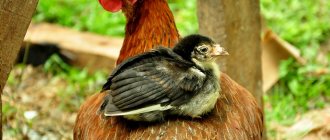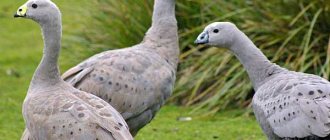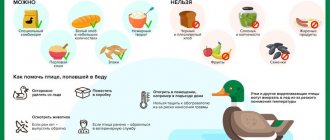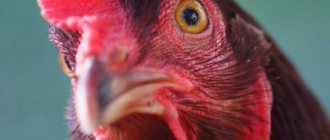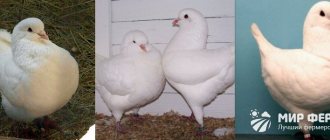2 438
3 comments
4
Author:
Sadchikov Nikolai Alekseevich.
Reading time: 4 minutes
Name of disease: Marek's disease (bird paralysis, polyneuritis, neurolymphomatosis)
Infectious viral disease
Symptoms of the acute form: paralysis of the limbs, difficulty breathing, severe exhaustion and loss of strength, refusal of food and water, pallor of the comb
Drugs for treatment: acyclovir, bifidumbacterin, tricolin
Vaccination is required for prevention
The disease is fatal to birds
To combat the disease, disinfection is carried out
Marek's disease (Marek's disease) is a highly contagious disease caused by a DNA virus that is not classified within subfamilies. The pathogen belongs to the family Hegresviridae, genus Hegresvirus group B. It is clinically characterized by the appearance of paralysis of the legs, wings or tail in birds, changes in the nervous system, and sectionally - the presence of cancer cells in the internal organs, skin and muscles.
Symptoms
Clinical symptoms are not always apparent, however, adverse effects on production are evident through reduced weight gain and reduced egg production. The incubation period, i.e. the time from the moment the virus enters until the first signs appear, ranges from several weeks to months. Initially, there are several cases without any symptoms. Then - a decrease in the weight of the birds, unilateral paralysis of the legs (the chickens sit in a splits position).
Expert opinion
Sadchikov Nikolay Alekseevich
Veterinarian ornithologist
Ask a Question
Cancerous tumors are observed in internal organs: liver, spleen, ovaries, heart, lungs, stomach, as well as within feather warts. In addition, sectional examination reveals hypoplasia of the lymphatic organs (bursa) and altered sciatic nerves, brachial plexus and vagus nerve.
The mortality rate reaches 80%, but can be significantly lower. The disease is highly contagious because the virus survives in the external environment for several months to a year. The affected individual becomes a carrier and must be isolated immediately.
What kind of disease is this?
Marek's disease is viral in nature and affects the tissues of internal organs and the functioning of the nervous system of birds.
There are three forms of the disease:
- Visceral – tumor growths on internal tissues.
- Ocular (ocular) – loss of vision partially or completely.
- Neural – consequences with paralysis and paresis in severe cases.
The causative agent of Marek's disease
The causative agent of Marek's disease is the Herpes virus. The infectivity is high; infected chickens do not spread the infection throughout the external environment immediately, but 7–20 days after the virus enters their body. One individual can be a carrier from six months to two years, in some cases for life. But when the chicken recovers, it acquires lifelong immunity, which it passes on to its offspring.
Did you know? There is no way to protect and prevent Marek's disease more effectively than timely vaccination.
Viral characteristics of the pathogen:
- good adaptability to environmental conditions, at a temperature of +25 ° C it can be pathogenic for five months, remaining in litter, eggs, excrement;
- affects at the cellular level.
Now there is no single special way to treat this disease, so if it is detected, the only thing that can be done is to carry out antiviral therapy, organize a quarantine zone, and send chickens to slaughter.
Sources and routes of infection
The route of transmission and infection is airborne. Particularly dangerous carriers are insects: flies and ticks. An infected bird exhaling the virus also serves as a source of epidemic. The virus spreads very quickly, entering the body through the respiratory tract. A bird can be a carrier, even if it is immune to the disease. In this case, she may not have any symptoms, she will be healthy. Therefore, it is not so easy to determine where the attack came from.
We recommend reading: Fertilizing homemade papaya
Historical reference
The disease was named after the Hungarian veterinary researcher József Marek, who first described the disease in 1907. The scientist himself called it “chicken polyneuritis,” but after that the disease was still left associated with the name of its discoverer. In Russia, they learned about Marek’s disease only in 1930, when they began studying it.
The development of a vaccine against the disease began only in 1970. Its basis is the use of active immunostimulants and virus strains to produce antibodies in birds. Today, vaccination of young livestock is the main measure of its protection.
Economic damage
The financial loss rate is quite high. Risks include:
- large culling of chickens;
- noticeable loss of heads;
- costs of quarantine measures;
- expenses for treatment, prevention;
- reduced productivity of laying hens.
The infection can cause quite significant financial damage to a large farm.
Acute form
In the acute (leukemia-like form), the incubation period lasts up to three weeks and occurs with high mortality of up to 70% of the birds in the flock. Some birds, despite the ongoing pathological process, may not have clinical manifestations. Then the birds die without preliminary symptoms of the disease. High mortality rates may persist for several weeks, and then individuals continue to die for several months. Symptoms:
- damage to the legs, neck and wings (during paralysis, birds lie with one limb extended forward and the other parallel to the back);
- difficulty breathing;
- drooping tail and wings;
- refusal of food and water;
- indigestion;
- severe exhaustion and loss of strength.
- pallor of the comb and earrings.
Vaccination
Vaccination against Marek's disease
Vaccination is most often carried out at one day of age. In some farms that have special equipment, intra-egg vaccination is carried out.
The method is not used at home. Vaccination given to a chicken before hatching is considered the most reliable way to prevent the disease, since infection of the bird in the first day of life is excluded.
When such chicks are sold, buyers are usually informed that intra-egg vaccination has been carried out. The vaccine with this method is administered on the 18th day of incubation, 3-4 days before the chicks hatch.
This procedure cannot be carried out without special equipment.
In less equipped poultry farms and in private backyards, vaccination is carried out on the first day after hatching. The vaccine is usually easy to purchase at veterinary pharmacies and specialized stores for farmers.
Be sure to read:
What to give chickens for worms, signs and how to remove them with drugs and folk remedies
The procedure should be carried out strictly following the instructions for the drug. The safest remedy is the turkey herpes vaccine. It is produced in liquid and dry forms.
Here is an example of 3 common vaccines:
- "Vaxxiek HVT+IBD"
- Marek's Rispens+HVT
- "Rispens CVI-988" (Rispens CVI-988)
All three options are supplied in containers with a double bottom (Dewar flask), in which liquid nitrogen is pumped, because the vaccine is stored at a temperature of -196 degrees.
Vaccines are administered subcutaneously and before use the vaccine must be diluted with a special solution following the instructions for use; a solution can be used as a solvent.
Permanent course of the disease
The incubation period is much longer, and the mortality rate is about 10-15%. Death lasts from several weeks to several months, usually in chickens at the beginning of the egg-laying season. The disease begins with paralytic symptoms:
- Paralysis of the wings and legs occurs. The birds adopt a characteristic split pose;
- sometimes there is torticollis;
- respiratory system disorder;
- exhaustion and diarrhea appear when the nerves and gastrointestinal tract are damaged;
- this form may be accompanied by changes in the eyeball. The shape of the pupil changes, the iris becomes gray or spotted, the ability to accommodate the eye is lost;
- Often older birds develop fluid in the abdominal cavity.
Does your bird have similar symptoms?
Not really
Prevention of the spread of Marek's disease. Disinfection of premises
In case of mass infection, all poultry kept on the farm are slaughtered and disposed of. Carry out thorough cleaning and disinfection of premises, work equipment, vehicles and surrounding areas. The poultry house is treated with drugs to kill rodents and insects that carry the infection. Chicken eggs in the incubator are treated with formaldehyde vapor.
Only hens and chicks vaccinated against Marek's disease can be placed in a clean room.
Restrictions on the sale of products are lifted if the young animals show no signs of illness for six months after the sanitary measures have been taken.
If symptoms of Marek's disease (developing in the classical form) appear in chickens once, all suspicious birds are destroyed. If slaughtered, the remaining chickens are completely gutted and the entrails are sent for disposal. Carcasses that do not show signs of infection by the virus are used to prepare sausages and canned food.
Pathological changes
Are as follows:
- Discover (at autopsy) diffuse or focal thickening of the lumbar and brachial nerve plexuses and nerve trunks.
- Sometimes tumors are in the gonads, lungs, heart, kidneys, liver, spleen.
- Atrophic changes in the muscles of the affected limbs and myocardium.
- Catarrhal inflammation of the gastrointestinal tract.
- Eye damage. Fusion of the iris with the lens or cornea is often detected. The shape of the pupil is changed, and swelling of the optic nerve is observed.
- Expansion of the goiter.
Treatment of broilers, laying hens
To eliminate infection with the disease in meat breeds and laying hens, vaccination is performed. Vaccinations are carried out on day-old chicks, revaccination is prescribed at the age of 10-20 days. Treatment of the disease is not advisable if 5% or 10% of the entire herd is infected. Since the virus is characterized by a high level of contagiousness.
A veterinarian should prescribe drugs for treatment of pathology, taking into account the entire medical history and the degree of progression of the disease. Treatment of Marek's pathology consists of taking Acyclovir.
Be sure to read:
Why the comb of chickens and roosters turns blue: reasons, what to do, preventive measures
Restoration of the stomach and intestinal tract of the bird is carried out with the help of Bifidumbacterin, which is prescribed in 1 dosage throughout the day. A sign of the bird's recovery is a herpes rash on the crest. During treatment, chickens lose their appetite.
It is recommended to administer food through a syringe. Full recovery of the individual is observed after 2 or 3 weeks.
Pathogenesis
The source of infection is sick chickens; their seratinized dead epithelial cells contain a completely virulent virus, which is adsorbed by blood leukocytes and spread by them to all organs and tissues. Together with the feather epithelium and dust particles, it enters the respiratory system of chickens. Then it penetrates through the blood along with macrophages into the thymus and bursa, disrupts their functions and immunosuppression begins. Gradually multiplies in other lymphoid organs: spleen, tonsils, bursa of Fabricius.
Complex virus particles are formed in the epithelial cells of the feather papillae, which are then released into the environment. Infected lymphocytes containing complete viral particles circulate in the blood. Persistent viremia occurs, which is a characteristic feature of infection with the Marek's disease virus. Virus seeding begins within 5 days of infection and lasts a lifetime. This is a constantly repeating cycle (applies to both vaccinated and unvaccinated birds).
Young birds up to 6 weeks of age are most susceptible to infection, but birds between 12 and 24 weeks of age and even older ones can become infected.
How is diagnostics carried out?
Making the correct diagnosis is not easy. Infection with the virus is quite common, but does not always lead to the development of the disease. Methods to detect infections:
- virus isolation;
- detection of viral DNA;
- detection of antigens in tissues;
- detection of antibodies.
There are other diagnostic methods - microscopic, biological, differential. Microscopically, three types of changes in peripheral nerves are distinguished:
- infiltration by mature lymphocytes;
- infiltration by maturing prolymphocytes;
- an abundant lymphoblastic infiltrate with numerous mitotic figures is interpreted as cancerous hyperplasia.
For biological examination, one-day-old chicks are used, infected intraperitoneally, subcutaneously or intramuscularly. The observation period is from 3 to 6 months, that is, until full clinical manifestation and falls.
When identifying Marek's disease, one should take into account other diseases in which the clinical manifestations and sectional picture are very similar: lymphocytic leukemia, eticuloendotheliosis, tuberculosis, histomonadosis, cancer tumors, congenital deformation of the pupil, diseases of the musculoskeletal system, vitamin deficiencies.
Causes of Marek's disease
Marek's disease is highly contagious. The causative agents of the infection are DNA-containing oncogenic herpes viruses. They are transmitted in several ways.
One of the causes of Marek's disease in birds is contact with sick chickens or virus carriers. Infection occurs mainly by aerogenic means. The virus outside the body dies quickly. But having penetrated into epithelial cells, it remains viable for a long time. Dust containing skin flakes and feather particles ends up on the mucous membranes of the bird's nose. Viruses attach to lymphocytes, spread to organs, and enter lymphoid and nervous tissue.
In chickens, infection with Marek's disease occurs in the incubator if there are particles of feathers and droppings from a sick chicken stuck to the shell. Rodents and parasitic insects can be carriers of infection. Infection also occurs if slaughterhouse waste is added to chicken feed. The herpes virus most often affects chickens, but cases of a similar disease in other birds have been observed: turkeys, quails, ducks, geese, swans.
Treatment and control of spread
Marek's disease is practically untreatable, but not all sick birds die; it happens that they cope with the disease on their own, and then acquire lasting immunity. In adult chickens, antiviral therapy can be performed, but only at the initial stage of the disease, until the bird shows signs of paralysis. It is better to give the injection behind the back, in the groin area or in the upper part of the neck: pull off the skin with your fingers and insert the needle. If the injection is intramuscular, then the bird's chest is the most favorable point.
In the acute form, infected individuals are killed. The only way to protect the herd is to vaccinate the young. After the slaughter of sick livestock, the poultry house must be thoroughly disinfected and only then a new batch of young animals should be placed in it. The carcass should be disposed of if skin or muscle tissue is involved in the pathological process, with signs of jaundice, or with exhaustion.
Diagnosis and treatment of Marek's disease in chickens
To identify the causative agent of infection, chicken carcasses are sent to the laboratory. The study makes it possible to distinguish Marek's disease from diseases such as avian influenza and plague, lymphoid leukemia, and salmonellosis. This will determine the degree of contagiousness of the disease and the possibility of treatment with antibiotics or antiviral agents.
The diagnosis of Marek's disease is made by testing chicken blood for the presence of antibodies to the herpes virus. Cytological and histological analyzes of internal organs, eyes, skin and muscles of dead chickens are carried out. Cells or pieces of tissue from embryos and day-old chicks are examined. Microscopic analysis and bacterial culture of swabs from chicken carcasses are performed to detect infectious agents of other species.
There are no specialized treatments for Marek's disease in chickens.
In the initial period of the disease, when there are still no signs of paralysis, antiviral therapy is carried out for adult birds using the drug "Acyclovir". However, the result cannot be predicted.
The surest way to prevent symptoms and treat Marek's disease in chickens is preventive vaccination. After this procedure, the birds’ bodies produce antibodies to this type of herpes virus.
To prevent the occurrence of Marek's disease in broilers, they are vaccinated at one day of age, and after 10-20 days they are re-vaccinated. In some farms that have the appropriate equipment, so-called “intra-vaccination” is carried out.
With timely implementation of such prevention, symptoms of Marek's disease in chickens either do not occur at all, or they manifest themselves weakly. As a rule, they have a mild skin form of the disease.
Poultry is vaccinated using domestic and foreign drugs based on strains of herpesvirus from chickens and turkeys.
Drugs used in treatment
Acyclovir is an antiviral drug, a synthetic analogue of purine nucleoside. It has the most pronounced antiviral activity against the Herpes simplex virus type 1. Give 1 tablet 200 mg daily for 2 days, then half for 5 days.
Bifidumbacterin is an antagonist of a wide range of pathogenic and opportunistic microorganisms. Immunomodulatory, normalizing the microflora of the gastrointestinal tract. A hen or chick is soldered once a day, using 1 bottle. After completion of treatment, continue for another 5 days at half the dose.
Tricolin is a complex drug that prevents DNA synthesis in the cell nuclei of microorganisms and has a bactericidal effect against gram-positive and gram-negative microorganisms. Drink for 7 days at the rate of 1 liter of the drug per 1 ton of water. Signs of bacterial infections disappear, and the chickens’ health improves on the 4th day.
Excellent 4
